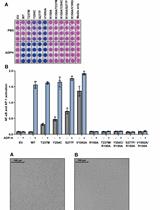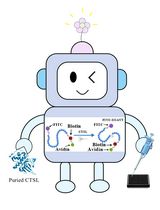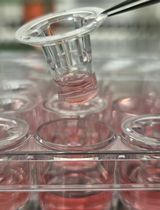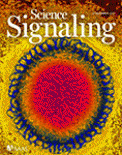- Submit a Protocol
- Receive Our Alerts
- Log in
- /
- Sign up
- My Bio Page
- Edit My Profile
- Change Password
- Log Out
- EN
- EN - English
- CN - 中文
- Protocols
- Articles and Issues
- For Authors
- About
- Become a Reviewer
- EN - English
- CN - 中文
- Home
- Protocols
- Articles and Issues
- For Authors
- About
- Become a Reviewer
Integrin Dependent RhoB Activation Assay Using Leukocytes
Published: Vol 8, Iss 23, Dec 5, 2018 DOI: 10.21769/BioProtoc.3105 Views: 3058
Reviewed by: Vaibhav B. ShahWoojong LeeAnonymous reviewer(s)

Protocol Collections
Comprehensive collections of detailed, peer-reviewed protocols focusing on specific topics
Related protocols

Measurement of the Activity of Wildtype and Disease-Causing ALPK1 Mutants in Transfected Cells With a 96-Well Format NF-κB/AP-1 Reporter Assay
Tom Snelling
Nov 20, 2024 1109 Views

Fluorescence Polarization-Based High-Throughput Screening Assay for Inhibitors Targeting Cathepsin L
Keyu Guo [...] Shuyi Si
Jul 20, 2025 1426 Views

Novel Experimental Approach to Investigate Immune Control of Vascular Function: Co-culture of Murine Aortas With T Lymphocytes or Macrophages
Taylor C. Kress [...] Eric J. Belin de Chantemèle
Sep 5, 2025 2506 Views
Abstract
To be able to migrate, leukocyte needs to re-use its adhesion molecules to move forward. These adhesion molecules are called integrins and are intracellularly transported via endocytosis and exocytosis in order to translocate to a new site on the cell membrane. The intracellular transportation is regulated by different small GTPases including RhoB. Here we describe an activation assay of RhoB in leukocytes migrating on ICAM-1Fc coated dishes using commercially available Rhoteikin coated agarose beads. Although this is a specific protocol for LFA-1 induced RhoB activation, it can also be used for RhoB activation induced by other soluble and insoluble factors.
Keywords: LeukocytesBackground
Leukocytes are frequently migrating to clear infections and/or to become activated in the lymph nodes. For a cell to move forward, it needs to be able to attach and reuse its integrins. These steps involve various small GTPases that control the intracellular transport of proteins. Small GTPases switch from active to inactive form by hydrolysis of GTP into GDP, which is controlled by specific GTPase-activating proteins (GAPs) and Guanine nucleotide exchange factors (GEFs) (Cavalli et al., 2001). RhoB is one of these important small GTPases that regulates endosomal trafficking of receptors in different cell types including leukocytes (Fernandez-Borja et al., 2005). We have recently found that the major integrin used by T lymphocytes, Lymphocyte function-associated antigen 1 (LFA-1) is recycled by a Rab11-dependent pathway that is controlled by RhoB activity (Samuelsson et al., 2017). Here, we present a protocol to measure RhoB activation based on the pulldown of active RhoB with commercially available Rhotekin-coated agarose beads. The Rhotekin-RBD protein specifically recognizes and binds to the active, GTP-bound form of the Rho protein. Furthermore, we describe integrin-dependent RhoB activation using coverslips coated with the integrin ligand ICAM-1Fc.
Materials and Reagents
- Pipette tips
- Coverslips (32 mm diameter) (VWR, catalog number: 631-0162)
- 6-well dish (SARSTEDT, catalog number: 833920)
- Microfuge tubes (SARSTEDT, catalog number: 72690.301)
- 96-well plate (SARSTEDT, catalog number: 821581.0019)
- PVDF membrane (Thermo Fisher Scientific, catalog number: 88518)
- Leukocytes (here we use human primary T lymphoblasts purified from whole blood)
- RhoB Activation Assay Kit (Cellbiolabs, catalog number: STA-403-B)
- ICAM-1Fc (Biolegend, catalog number: 552904)
- Bovine serum albumin (BSA) (Sigma-Aldrich, catalog number: A1933)
- PierceTM Coomassie Plus Bradford assay reagent and BSA-standard (Thermo Fisher Scientific, catalog numbers: 23238 and 23209, respectively)
- Primary antibodies
- RhoB (Santa Cruz Biotechnology, catalog number: sc-180) or use the RhoB antibody included in the RhoB Activation Assay Kit
- LFA-1 (m38) (GeneTex, catalog number: GTX26132)
- α-Actin (Sigma-Aldrich, catalog number: A5441)
- Secondary antibodies
- Goat anti-Rabbit IgG-HRP (Thermo Fisher Scientific, catalog number: 31460)
- Sheep anti-Mouse IgG-HRP (GE Healthcare, Amersham, catalog number: NA9310V)
- PierceTM ECLplus Western Blotting substrate (Thermo Fisher Scientific, catalog number: 32132)
- 70% ethanol
- 5% milk powder
- Methanol
- Buffers
- HEPES (Thermo Fisher Scientific, catalog number: 15630080)
- Protease inhibitors (cOmpleteTM Mini EDTA-free Protease Inhibitor Cocktail, Roche) (Sigma-Aldrich, catalog number: 11836170001)
- Tween 20 (Thermo Fisher Scientific, catalog number: TA-125-TW)
- Phosphate buffered saline (PBS) (Thermo Fisher Scientific, catalog number: 14040133)
- Hank’s balanced salt solution (HBSS) with or without Ca2+/Mg2+ (Thermo Fisher Scientific, Gibco, catalog numbers: 14025092 and 14175095)
- 2x reducing SDS-PAGE buffer (Sigma-Aldrich, catalog number: S3401-10VL)
- HBSS wash buffer (see Recipes)
- Migration buffer (see Recipes)
Equipment
- Pipettes
- Forceps
- Centrifuges (refrigerated microcentrifuge and swing out centrifuge with plate holders)
- Rocker/shaker
- Plate reader capable of measuring absorbance at the wavelength appropriate to the protein assay (e.g., 595 nm for Protein Assay)
- Electrophoresis system
- Immunoblotting system
- Incubator
Software
- ImageJ (NIH)
Procedure
- Coating of coverslips
- Clean 6 coverslips (diameter 32 mm) by incubating them in 70% ethanol for 5 min and rinse with distilled water. Let the coverslips air dry before use.
Note: We use 6 coverslips for ICAM-1Fc to get roughly the same amount of protein as in 1 ml soluble T cells (2 x 107 ~2 mg of total protein). - To coat the coverslips, place the 32 mm coverslips in a 6-well dish and add 500 μl of 5 μg/ml ICAM-1 Fc in PBS. Add a second coverslip on top. This sandwich reduces the amount of ICAM-1 Fc required for coating.
Note: We are using in-house made ICAM-1Fc 5 μg/ml, but there is commercially available ICAM-1Fc as well. - Incubate overnight at 4 °C.
- Separate the two coverslips by removing the top one with forceps and turn over the coverslip, so that the coated side faces upwards and place the coverslip in an empty well.
- Block unspecific binding by adding 2 ml of 2.5% BSA in PBS and incubate for 1 h at room temperature (RT).
- Wash twice with 1 ml PBS and once with 1 ml HBSS.
- Add 1 ml HBSS wash buffer (Recipe 1) to keep the coverslips wet before adding cells. Remove this liquid before adding cells.
- Clean 6 coverslips (diameter 32 mm) by incubating them in 70% ethanol for 5 min and rinse with distilled water. Let the coverslips air dry before use.
- Adhesion of human primary T lymphocytes on ICAM-1
- Wash 8 x 107 T lymphocytes (see Notes) in HBSS wash buffer and centrifuge at 300 x g for 10 min at 4°C.
- Resuspend cells into 2 x 107/ml in migration buffer (Recipe 2).
- Transfer 1 ml cells into a microfuge tube for an unstimulated control and then 1 ml on top of each of the ICAM-1 coated coverslips in the 6-well plate for the LFA-1 activation samples.
- Incubate all samples at 37 °C for 20 min.
- Centrifuge the microfuge tube at 300 x g for 10 min at 4 °C.
- Wash twice with ice cold PBS.
- Remove and discard the suspension carefully from the wells and the supernatant from the microfuge tube.
Important: Keep both the plate and microfuge tube on ice all the time. - Resuspend the cell pellet in the microfuge tube in 500 μl lysis buffer containing protease inhibitors and incubate on ice for 20 min. Add 500 μl lysis buffer containing protease inhibitors into the first well with an ICAM-1 Fc coated coverslip and pipette up and down to lyse the adhered cells, then transfer the suspension into the adjacent well until all adhered cells have been lysed. Transfer the lysate into a new microfuge tube and incubate on ice for 20 min.
Note: Prepare fresh lysis buffer from the 5x Lysis buffer included in the kit and add protease inhibitors (1 tablet/10 ml lysis buffer). - Clear the lysates by centrifugation at 14,000 x g for 10 min at 4 °C.
- Transfer the supernatant to a new microfuge tube and keep on ice.
- Measuring protein content using Bradford assay
- Take 2 μl from each sample and add 58 μl ddH2O (1:30 dilution).
- Mix and add duplicates to a 96-well plate (10 μl/well).
- Add also undiluted BSA standard (Bio-Rad, quick start) in duplicates.
- Dilute Bradford solution 1:5 in ddH2O.
- Add 200 μl of diluted Bradford solution per well.
- Incubate at RT for 10 min, keep dark.
- Measure absorbance with a plate reader at 595 nm wavelength.
- Calculate protein concentration from the standard curve obtained.
- Dilute the samples in lysis buffer to the exactly same concentration and remove 50 μl from each sample for total cell lysate (TCL).
- RhoB activation
Note: When setting up the assay, include the positive (GTPγS) and negative controls (GDPγS) and follow the manufacturer’s protocol and use additional number of cells in solution for this step.- Add equal amounts of lysates to microcentrifuge tubes and adjust the volume of each sample to 1 ml with lysis buffer.
- Thoroughly resuspend the Rhotekin RBD agarose bead slurry included in the kit by vortexing or triturating.
- Quickly add 40 μl of resuspended bead slurry to each tube.
- Incubate the tubes at 4 °C for 1 h with gentle agitation.
- Pellet the beads by centrifugation at 14,000 x g for 10 s.
- Aspirate and discard the supernatant.
- Wash the beads 3 x with 0.5 ml of lysis buffer each.
- Carefully remove the supernatant and resuspend the pellets in 40 μl 2x SDS-PAGE sample buffer.
- Boil each sample at 97 °C for 5 min.
- Centrifuge each sample at 14,000 x g for 10 s.
- Western blotting
- Run on an 8% polyacrylamide gel and do not forget the TCL for the total amount of proteins.
Note: We load the pulldown of active RhoB and TCL on separate gels. It is always good to also include the RhoB immunoblot positive control since the RhoB antibodies are tricky to work with. We load 20 μl in each well. - Transfer at 90 V for 110 min.
Note: We used PVDF membrane and PBS for all our antibodies. If you use the RhoB antibody provided in the kit, use PVDF and TBS. PVDF membrane needs to be activated in 100% methanol prior to transfer. - Rinse in PBS/0.1% Tween 20.
- Block the membrane in 5% milk powder in PBS/0.1% Tween 20 for 2 h at RT.
- Rinse in PBS/0.1% Tween-20.
- Incubation with primary antibodies:
Membranes with pulldown active RhoB samples are stained with RhoB (1:500) and LFA-1 (1:1,000). Membranes containing TCL samples are stained with Actin (1:2,000), RhoB (1:500) and LFA-1 (1:1,000) overnight at RT.
Notes:- We used the RhoB polyclonal antibody clone sc-180 (batch specific) from Santa Cruz Biotechnology and not the one included in the kit since clone sc-180 works better for the primary T lymphoblasts we use.
- To be able to detect the interaction of LFA-1 with active RhoB we stained with total LFA-1 (clone m38) on the membrane run with pulldown samples. We used in-house produced m38 antibody. However, the same clone is commercially available.
- We always stain the TCL with actin for loading control as well as RhoB and LFA-1 to see the total amount of these proteins.
- Wash 3 x 5 min in PBS/0.1% Tween 20.
- Secondary antibody incubation: anti-rabbit-HRP (1:2,000)/anti-mouse-HRP (1:10,000) for 1 h at RT.
- Wash 3 x 10 min in PBS/0.1% Tween 20.
- ECL detection.
- Run on an 8% polyacrylamide gel and do not forget the TCL for the total amount of proteins.
Data analysis
- Scan X-ray films from ECL-Western Blots.
- Quantify protein band density with ImageJ.
- Draw a rectangular region of interest (ROI) around each band and measure the pixel intensity.
- Draw ROI of the same size in close vicinity to each band and measure background pixel intensity.
- Calculate background corrected band intensity. From band Raw Integrated Density (RawIntDen), subtract referring value of background RawIntDen.
Notes
In this protocol, we used human primary T lymphoblasts. Naturally, other cells can be used as well. See Samuelsson et al. (2017) for the primary T lymphoblast purification procedure.
Recipes
- HBSS wash buffer
HBSS without Ca2+/Mg2+
10 mM HEPES - Migration buffer
HBSS with Ca2+/Mg2+ without phenol red (Gibco)
5 mM Mg2+
10 mM HEPES
Acknowledgments
We would like to thank Dr. Nancy Hogg (The Francis Crick Institute, UK) for the kind gift of the LFA-1 antibody. This protocol was adopted from Samuelsson et al. (2017). This work was supported by Swedish Research Council awards K2010-80P-21592-01-4 and K2010-80X-215917-01-4, Foundation Olle Engvist Byggmästare, I & A Lundberg Research Foundation, Royal Swedish Academy of Science, Åke Wiberg Foundation, Jeanssons Foundation, Kocks Foundation, P & U Schybergs Foundation, Gyllenstiernska Krapperup Foundation, Gustav V 80 Jubilee Fund, Österlund Foundation, Nanna Svartz, Crafoord Awards Anna-Greta Crafoord Foundation and Royal Physiographic Society of Lund.
Competing interests
The authors declare no competing interest.
References
- Cavalli, V., Corti, M. and Gruenberg, J. (2001). Endocytosis and signaling cascades: a close encounter. FEBS Lett 498(2-3): 190-196.
- Fernandez-Borja, M., Janssen, L., Verwoerd, D., Hordijk, P. and Neefjes, J. (2005). RhoB regulates endosome transport by promoting actin assembly on endosomal membranes through Dia1. J Cell Sci 118(Pt 12): 2661-2670.
- Samuelsson, M., Potrzebowska, K., Lehtonen, J., Beech, J. P., Skorova, E., Uronen-Hansson, H. and Svensson, L. (2017). RhoB controls the Rab11-mediated recycling and surface reappearance of LFA-1 in migrating T lymphocytes. Sci Signal 10(509).
Article Information
Copyright
© 2018 The Authors; exclusive licensee Bio-protocol LLC.
How to cite
Lehtonen, J., Potrzebowska, K., Samuelsson, M. and Svensson, L. (2018). Integrin Dependent RhoB Activation Assay Using Leukocytes. Bio-protocol 8(23): e3105. DOI: 10.21769/BioProtoc.3105.
Category
Immunology > Immune cell function > Lymphocyte
Biochemistry > Protein > Activity
Do you have any questions about this protocol?
Post your question to gather feedback from the community. We will also invite the authors of this article to respond.
Tips for asking effective questions
+ Description
Write a detailed description. Include all information that will help others answer your question including experimental processes, conditions, and relevant images.
Share
Bluesky
X
Copy link








